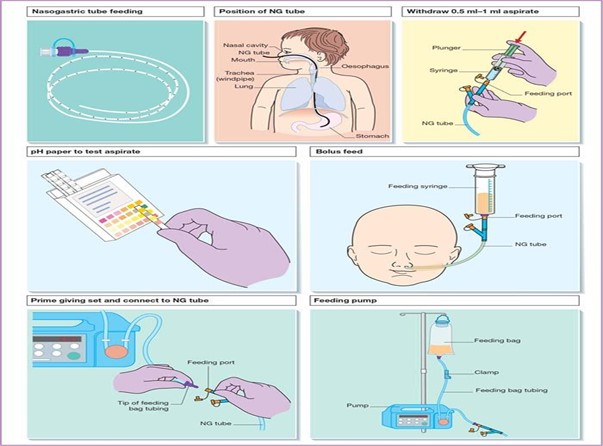The nurse is caring for a client diagnosed with type 1 diabetes mellitus who uses both short-acting and long-acting insulin adjusted doses throughout the day. Which nutrient is essential for the client to count for each meal and snacks?
Protein.
Carbohydrates.
Dairy.
Fats
The Correct Answer is B
Choice A
Protein is not essential. While protein can influence blood sugar levels to some extent, its effect is much smaller compared to carbohydrates. Protein is not typically counted as a primary factor in insulin dosing.
Choice B
Carbohydrates are essential. For a client with type 1 diabetes mellitus who uses both short-acting (mealtime) and long-acting (basal) insulin, counting carbohydrates is essential for meal planning and insulin dosing. Carbohydrates have the most direct and significant impact on blood sugar levels. When carbohydrates are consumed, they are broken down into glucose, which enters the bloodstream and can lead to increased blood sugar levels
Choice C
Dairy is not essential. Dairy products can contain carbohydrates (such as lactose), but the carbohydrate content varies and is not as significant as in foods like grains, fruits, and starchy vegetables.
Choice D
Fats are not essential. Fats have minimal direct impact on blood sugar levels. However, they can affect the overall rate of digestion and absorption of carbohydrates, potentially influencing the timing of insulin administration. But carbohydrate counting remains the primary focus for insulin adjustment.
Nursing Test Bank
Naxlex Comprehensive Predictor Exams
Related Questions
Correct Answer is B
Explanation
Choice A
Client with a nasogastric tube to low, intermittent suction is not correct. While there is a risk of aspiration with a nasogastric tube in place, the tube is intended to help drain stomach contents, reducing the risk of aspiration. However, if the tube is not properly positioned or managed, there could still be some risk.
Choice B
Client who has sensory aphasia and is receiving a clear liquid diet is correct. Sensory aphasia refers to a language disorder that affects a person's ability to understand language and communication. This client may have difficulty swallowing safely and effectively, which increases the risk of aspiration. Additionally, a clear liquid diet consists of thin liquids that are more likely to be aspirated compared to thicker fluids.
Choice C
Client receiving 30% oxygen via a non-rebreather face mask is not correct. Oxygen therapy can increase the risk of drying the airways and potentially increasing the risk of aspiration, but if the oxygen mask is properly fitted and humidified, the risk may be minimized.
Choice D
Client experiencing dysphagia who is prescribed a full liquid diet is not correct. Dysphagia refers to difficulty swallowing, which can increase the risk of aspiration. However, a full liquid diet includes thicker liquids that are less likely to be aspirated compared to thin liquids. Still, the risk of aspiration exists, especially if the client has severe dysphagia.
Correct Answer is A
Explanation
Choice A
Demonstrating correct measurement of the tube insertion length is the first priority. Inserting a nasogastric tube to the appropriate length is crucial for ensuring that the tube reaches the stomach and is not inserted too far. Incorrect insertion length can lead to complications, discomfort, or potential harm to the patient. Therefore, demonstrating and ensuring the correct measurement of the tube insertion length takes priority.:
Choice B
Reminding the nurse to apply lubricant to the tube before insertion is not first priority. Applying lubricant helps ease the insertion process, but it is not the most critical step to prioritize initially.
Choice C
Confirming that the nurse has auscultated the client's bowel sounds is not the first priority. Bowel sounds assessment is important to ensure proper placement, but this step can be done after ensuring the correct measurement of the insertion length.
Choice D
Elevating the head of the bed before the nurse inserts the tube is not the first priority: Elevating the head of the bed helps facilitate the passage of the tube into the stomach, but it is not the first priority in this context.

Whether you are a student looking to ace your exams or a practicing nurse seeking to enhance your expertise , our nursing education contents will empower you with the confidence and competence to make a difference in the lives of patients and become a respected leader in the healthcare field.
Visit Naxlex, invest in your future and unlock endless possibilities with our unparalleled nursing education contents today
Report Wrong Answer on the Current Question
Do you disagree with the answer? If yes, what is your expected answer? Explain.
Kindly be descriptive with the issue you are facing.
